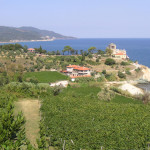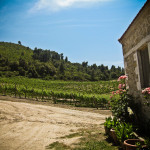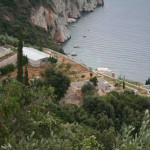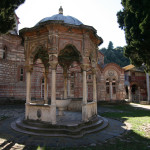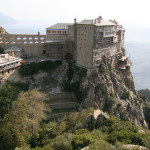Athos, Geography and History
Mount Athos (Greek: Όρος Άθως, Oros Athos; English pronunciation: /ˈæθɒs/, Greek pronunciation: [ˈaθos]) is a mountain and peninsula in Macedonia, Greece. A World Heritage Site, it is home to 20 Eastern Orthodox monasteries and forms a self-governed monastic state within the sovereignty of the Hellenic Republic. Spiritually, Mount Athos comes under the direct jurisdiction of the Ecumenical Patriarchate of Constantinople. Today Greeks commonly refer to Mount Athos as the “Holy Mountain” (Greek: Άγιον Όρος, Agion Oros/Hagion Oros). In Classical times, the peninsula was called Akté (Ακτή) (sometimes Acte or Akte).
The peninsula, the easternmost “leg” of the larger Halkidiki peninsula, protrudes 50 kilometres (31 mi) into the Aegean Sea at a width of between 7 and 12 kilometres (4.3 and 7.5 mi) and covers an area of 335.637 square kilometres (129.59 sq mi). The actual Mount Athos has steep, densely forested slopes reaching up to 2,033 metres (6,670 ft). The surrounding seas, especially at the end of the peninsula, can be dangerous. In ancient Greek history two fleet disasters in the area are recorded: In 492 BC Darius, the king of Persia, lost 300 ships under general Mardonius (Herodotus “Histories” book VI (Erato), Aeschylus “The Persians”). In 411 BC the Spartans lost a fleet of 50 ships under admiral Epicleas. (Diodorus Siculus, “Bibliotheca historica” XIII 41, 1–3).
Though land-linked, Mount Athos is accessible only by a single boat, the St. Eshpigmenitis. The daily number of visitors entering Mount Athos is restricted and all are required to obtain a special entrance permit valid for a limited period. Only males are allowed entrance into Mount Athos, which is called “Garden of the Virgin” by monks, and Orthodox Christians take precedence in the permit issuance procedure. Only males over the age of 18 who are members of the Eastern Orthodox Church are allowed to live on Athos, either as monks or as workers.
List of religious institutions:
Twenty monasteries
The sovereign monasteries, in the order of their place in the Athonite hierarchy:
- Great Lavra monastery (Μεγίστη Λαύρα, Megísti Lávra, Great Lavra)
- Vatopedi monastery (Βατοπέδι or Βατοπαίδι)
- Iviron monastery (Ιβήρων; ივერთა მონასტერი, iverta monasteri) – built by Georgians
- Helandariou monastery (Χιλανδαρίου, Chilandariou;Хиландар) – Serbian Orthodox
- Dionysiou monastery (Διονυσίου)
- Koutloumousiou monastery (Κουτλουμούσι)
- Pantokratoros monastery (Παντοκράτορος, Pantokratoros)
- Xiropotamou monastery (Ξηροποτάμου)
- Zografou monastery (Ζωγράφου; Зограф) – Bulgarian Orthodox
- Dochiariou monastery (Δοχειαρίου)
- Karakalou monastery (Καρακάλλου)
- Filotheou monastery (Φιλοθέου)
- Simonos Petras monastery (Σίμωνος Πέτρα or Σιμωνόπετρα)
- Agiou Pavlou monastery (Αγίου Παύλου, Agiou Pavlou, Saint Paul’s)
- Stavronikita monastery (Σταυρονικήτα)
- Xenophontos monastery (Ξενοφώντος)
- Osiou Grigoriou monastery (Οσίου Γρηγορίου, Venerable Gregory)
- Esphigmenou monastery (Εσφιγμένου)
- Agiou Panteleimonos monastery (Αγίου Παντελεήμονος, Agiou Panteleimonos, Saint Pantelemon; Пантелеймонов; or Ρωσικό, Rossikon) – Russian Orthodox
- Konstamonitou monastery (Κωνσταμονίτου)
Twelve sketes
A skete is a community of Christian hermits following a monastic rule, allowing them to worship in comparative solitude, while also affording them a level of mutual practical support and security. There are two kinds of sketes in Mount Athos. A koenobitic skete follows the style of monasteries. An idiorrhythmic skete follows the style of a small village: it has a common area of worship (a church), with individual hermitages or small houses around it, each one for a small number of occupants. There are 12 official sketes on Mount Athos.
- Agias Annas
- Agias Triados or Kafsokalyvíon
- Timiou Prodromou
- Agiou Andrea
- Agiou Dimitriou
- Timiou Prodromou Iviron
- Agiou Panteleimonos
- Profiti Ilia
- Theotokou or Nea Skiti
- Agiou Dimitriou tou Lakkou or Lakkoskiti
- Evangelismou tis Theotokou
- Bogoroditsa
Timeline of Mount Athos
- 9th century BC. Mythical ages
- 8th – 7th century BC. Settlement of Thracians on the Athos pepninsula.
- 6th century BC. Greeks came on the penisnula and hellenised it.
- 5th – 2nd century BC 6 to 7 cities of the peninsula were colonies of Greek states and they were autonomous.
- 493, The fleet of Persian General Mardonios was destroyed at the Athonian coast.
- 481, Xerxes constructed the Canal close to today’s location of Provlakas.
- 468, Athos area came under the rule of the Romans.
- 324 – 337 AD., Whole Macedonia and Athos joined Illyricon and in 379 the Eastern Illyricon.
- 412, Temporarily attached (and since 716-744 finally) to the bishop of Constantinople.
- 5th century. The monastic life was popularised in Athos.
- 842, Athos monks attended the Synod of Constantinople to restore the icons.
- 9th century, Icons transitions to Athos cause of the iconoclasts.
- 874, Chrysobull of Vasileios Makedonos I, referring to the monachism of Halkidiki’s peninsula.
- 9th – 10th century. Lived on the peninsula Petros the Athonite and Euthimios the Thessalonikean.
- 934, The cathedra of Elders (as the monastic center of Athos) and called “ancient”.
- 963, Foundation of Monastery Megistis Lavras from monk Athanasios Trapezounta.
- 972, Written the First Typikon of Mount Athos (Ioannis Tsimiskis).
- 980, Foundation of Monastery Iviron.
- 10th – 11th century. Foundation of monasteries Xeropotamou, Vatopediou, Xenofontos, Amalfinon, Zografou, Konstamonitou, Karakallou, Filotheou and Koutloumousiou.
- 1045, Athos is named “Agion Oros” according to chrysobull of emperor Konstantinos I Monomachos.
- 1046, Written the Typikon B of Mount Athos.
- 1050 approximately, 125 monasteries of Mount Athos.
- 1080 – 1120, Two hundred families arrived to Athos and disturbed the monks residents.
- 1198, A monydrio was raised at the monastery of Hilandari from the Serbian ruler Stephan and his son Rasko.
- 13th century. Seizures by the pirates and the crusaders of the Fourth Crusade. In a letter of Pope Innocent called Athos a sacred place, House of God and Gate of Heaven.
- 1307 -1309, Lots of monasteries were destroyed from Catalans adventurers-mercenaries.
- 14th century. Athos had a spiritual acme. The monasteries of Gregoriou, Simonos Petra, Pantokratora, and St Paul, the movement of Hesychasts was developed, and the catholics of the monasteries Hilandari, Vatopedi a.o, apart from the Protato were decorated according the principles of Macedonian School.
- 1394, Written the Third Typikon of Mount Athos (Typikon of Antonios).
- 1406, With a chrysobull of Manuel IIPaleologos (Fourth Typikon), the monks were given the right of property and possession and prohibited the entry to women in Mount Athos.
- 1430, 1453, The Athonians monks secured privileges from the Turks rulers.
- 1453 -1913, Mount Athos was under the Ottoman Rule.
- 1533, Foundation of Monastery Stavronikita.
- 16th century, There were decorated according the style of Cretan School the Trapeza of M.Lavra and its Catholic(Molivoklissia), the Catholics of monasteries Koutloumousiou, Stavronikita, Dionisiou, Docheiariou, others trapezas of monasteries and chapels a.o.
- 1575, Written the Fifth Typikon of Mount Athos.
- 17th century. Poverty and illiteracy plagued the monks. The skete of St. Anna was founded and the coenobitic monasteries were changed to idiorrythmic.
- 1700 -1750, Foundation of sketes Kafsokalivia, Timiou Prodromou, St. Demetrios (Vatopedi), Nea or Pirgos, St. Demetrios (St Paul), Annunciation of Virgin Mary and St Panteleiomonas.
- 1720 -1730, Action in Karies of painter and historian Dionysius from Fourna Agrafa.
- 1743, Foundation of AThoniada School close to Monastery Vatopedi.
- 1755, Operation of printing office at the Monastery of M. Lavra for two generations.
- 1750-1800, The movement of Kollivades upseted Mount AThos.
- 1782, Written the 6th Typikon of Mount Athos.
- 1784-1818, Seven idiorrythmic monasteries were changed to coenobitic.
- 1810, Written the 7th Typikon of Mount Athos (Patriarch Gregorios the Fifth). Establishment of the Holy Community.
- 1821-1830, Entrance and stay of Turkish army in Mount Athos.
- 1839-1850, Four idiorrythmic monasteries were changed to coenobitic
- 1842, Foundation of Athoniada School in Karies.
- 1850-1900, Renovated lots of Athonians buildings and built new ones.
- 1912, November 2. Squadron of Greek fleet occupied Athos peninsula.
- 1923, The Treaty of Lausanne recognized Greek sovereignty in all Mount Athos.
- 1924, Written the Charter Map of Mount Athos.
- 1963, Celebration of the Millenium of the organized monastic life in Karies, Thessaloniki and Athens.
- 1971-1982, Five idiorrythmic monasteries were changed to coenobitic
Antiquity
In the context of Greek mythology Athos was the name of one of the Gigantes that challenged the Greek gods during the Gigantomachia. Athos threw a massive rock against Poseidon which fell in the Aegean sea and became the Athonite Peninsula. According to another version of the story, Poseidon used the mountain to bury the defeated giant.
Herodotus tells us that Pelasgians from the island of Lemnos populated the peninsula, then called Acte or Akte. (Herodotus, VII:22) Strabo reports of five cities on the peninsula: Dion (Dium), Cleonae (Kleonai), Thyssos (Thyssus), Olophyxos (Olophyxis), Acrothoï (Akrothoön), of which the last is near the crest. (Strabo, Geography, VII:33:1) Eretria also established colonies on Acte. Two other cities were established in the Classical period: Acanthus (Akanthos) and Sane. Some of these cities minted their own coins.
The peninsula was on the invasion route of Xerxes I, who spent three years [5] excavating a channel across the isthmus to allow the passage of his invasion fleet in 483 BC. After the death of Alexander the Great, the architect Dinocrates (Deinokrates) proposed to carve the entire mountain into a statue of Alexander.
The history of the peninsula during latter ages is shrouded by the lack of historical accounts. Archaeologists have not been able to determine the exact location of the cities reported by Strabo. It is believed that they must have been deserted when Athos’ new inhabitants, the monks, started arriving at some time before the 7th century AD.
Early Christianity
According to the athonite tradition, the Blessed Virgin Mary was sailing accompanied by St John the Evangelist from Joppa to Cyprus to visit Lazarus. When the ship was blown off course to then pagan Athos it was forced to anchor near the port of Klement, close to the present monastery of Iviron. The Virgin walked ashore and, overwhelmed by the wonderful and wild natural beauty of the mountain, she blessed it and asked her Son for it to be her garden. A voice was heard saying “Ἔστω ὁ τόπος οὖτος κλῆρος σός καί περιβόλαιον σόν καί παράδεισος, ἔτι δέ καί λιμήν σωτήριος τῶν θελόντων σωθῆναι” (Translation: “Let this place be your inheritance and your garden, a paradise and a haven of salvation for those seeking to be saved”). From that moment the mountain was consecrated as the garden of the Mother of God and was out of bounds to all other women.
Historical documents on ancient Mount Athos history are very few. It is certain that monks have been there since the 4th century, and possibly since the 3rd. During Constantine I’s reign (324–337) both Christians and pagans were living there. During the reign of Julian the Apostate (361–363), the churches of Mount Athos were destroyed, and Christians hid in the woods and inaccessible places. Later, during Theodosius I’s reign (383–395), the pagan temples were destroyed. The lexicographer Hesychius of Alexandria states that in the 5th century there was still a temple and a statue of “Zeus Athonite”. After the Islamic conquest of Egypt in the 7th century, many orthodox monks from the Egyptian desert tried to find another calm place; some of them came to the Athos peninsula. An ancient document states that monks “…built huts of wood with roofs of straw (…) and by collecting fruit from the wild trees were providing themselves improvised meals…”
Byzantine era: the first monasteries
The chroniclers Theophanes the Confessor (end of 8th century) and Georgios Kedrenos (11th century) wrote that the 726 eruption of the Thera volcano was visible from Mount Athos, proving that it was inhabited at the time. The historian Genesios recorded that monks from Athos participated at the 7th Ecumenical Council of Nicaea of 787. Around 860, the famous monk Efthymios the Younger came to Athos and a number of monk-huts (“skete of Saint Basil”) were created around his habitation, possibly near Krya Near. During the reign of emperor Basil I the Macedonian, the former Archbishop of Crete (and later of Thessaloniki) Basil the Confessor built a small monastery at the place of the modern harbour (“arsanas”) of Hilandariou Monastery. Soon after this, a document of 883 states that a certain Ioannis Kolovos built a monastery at Megali Vigla.
On a chrysobull of emperor Basil I, dated 885, the Holy Mountain is proclaimed a place of monks, and no laymen or farmers or cattle-breeders are allowed to be settled there. The next year, in an imperial edict of emperor Leo VI the Wise we read about the “…so-called ancient seat of the council of gerondes (council of elders)…”, meaning that there was already a kind of monks’ administration and that it was already “ancient”. In 887, some monks expostulate to the emperor Leo the Wise as the monastery of Kolovos is growing more and more and they lose their peace.
In 908, the existence of a Protos (“First monk”) is documented, who is the “head” of the monastic community. In 943, the borders of the monastic state was precisely mapped while we know that Karyes is already the capital town and seat of the administration and has the name “Megali Mesi Lavra” (Big Central Assembly). In 956, a decree offered land of about 940,000 m2 (10,118,075.79 sq ft) to the Xiropotamou monastery, which means that this monastery was already quite big.
In 958, the monk Athanasios the Athonite (Άγιος Αθανάσιος ο Αθωνίτης) arrived on Mount Athos. In 962, he builds the big central church of the “Protaton” in Karies. In the next year, with the support of his friend, Emperor Nicephorus Phocas, the monastery of Great Lavra was founded, still the largest and most prominent of the 20 monasteries existing today. It enjoyed the protection of the emperors of the Byzantine Empire during the following centuries and its wealth and possessions grew considerably. The Fourth Crusade in the 13th century brought new Roman Catholic overlords which forced the monks to complain and ask for the intervention of Pope Innocent III, until the restoration of the Byzantine Empire came. The peninsula was raided by Catalan mercenaries in the 14th century, a century that also saw the theological conflict over the hesychasm practised on Mount Athos and defended by Gregory Palamas (Άγιος Γρηγόριος ο Παλαμάς).
Ottoman era
The Byzantine Empire was conquered in the 15th century and the newly established Islamic Ottoman Empire took its place. The Athonite monks tried to maintain good relations with the Ottoman Sultans and therefore when Murad II conquered Thessaloniki in 1430 they immediately pledged allegiance to him. In return, Murad recognized the monasteries’ properties, something which Mehmed II formally ratified after the fall of Constantinople in 1453. In this way the Athonite independence was somewhat guaranteed.
The 15th and 16th centuries were particularly peaceful for the Athonite community. This led to relative prosperity for the monasteries. An example of this is the foundation of Stavronikita monastery which completed the current number of Athonite monasteries. Following the conquest of the Serbian Despotate by the Ottomans many Serbian monks came to Athos. The extensive presence of Serbian monks is depicted in the numerous elections of Serbian monks to the office of the Protos during the era.
Sultan Selim I was a substantial benefactor of the Xiropotamou monastery. In 1517, he issued a fatwa and a Hatt-i Sharif (“noble edict”) that “the place, where the Holy Gospel is preached, whenever it is burned or even damaged, shall be erected again.” He also endowed privileges to the Abbey and financed the construction of the dining area and underground of the Abbey as well as the renovation of the wall paintings in the central church that were completed between the years 1533–1541.
Despite the fact that most time the monasteries were left on their own, the Ottomans heavily taxed them and sometimes they seized important land parcels from them. This eventually culminated in an economic crisis in Athos during the 17th century. This led to the adoption of the so called “idiorrhythmic” lifestyle (a semi-eremitic variant of Christian monasticism) by a few monasteries at first and later, during the first half of the 18th century, by all.
This new way of monastic organization was an emergency measure taken by the monastic communities to counter their harsh economic environment. Contrary to the cenobitic system, monks in idiorrhythmic communities have private property, work for themselves, they are solely responsible for acquiring food and other necessities and they dine separately in their cells, only meeting with other monks at church. At the same time, the monasteries’ abbots were replaced by committees and at Karyes the Protos was replaced by a four member committee.
In 1749 with the establishment of the Athonite Academy near Vatopedi monastery, the local monastic community took a leading role in the modern Greek Enlightenment movement of the 18th century.[11] This institution offered high level education, especially under Eugenios Voulgaris, where ancient philosophy and modern physical science were taught.
Russian tsars, and princes from Moldavia, Wallachia and Serbia (until the end of the 15th century) helped the monasteries survive with large donations. The population of monks and their wealth declined over the next centuries, but were revitalized during the 19th century, particularly by the patronage of the Russian government. As a result, the monastic population grew steadily throughout the century, reaching a high point of over 7,000 monks in 1902.
In 1912, during the First Balkan War, the Ottomans were forced out by the Greek Navy. Greece claimed the peninsula as part of the peace treaty of London signed on May 30, 1913. As a result of the shortcomings of the Treaty of London, the Second Balkan War broke out between the combatants in June 1913. A final peace was agreed at the Treaty of Bucharest on 10 August 1913.
In June 1913 a small Russian fleet, consisting of the gunboat Donets and the transport ships Tsar and Kherson, delivered the archbishop of Vologda, and a number of troops to Mount Athos to intervene in the theological controversy over imiaslavie (a Russian Orthodox movement).
Τhe archbishop held talks with the imiaslavtsy and tried to make them change their beliefs voluntarily, but was unsuccessful. On July 31 the troops stormed the St. Panteleimon Monastery. Although the monks were not armed and did not actively resist, the troops showed very heavy-handed tactics. After the storming of St. Panteleimon Monastery, the monks from the Andreevsky Skete (Skiti Agiou Andrea) surrendered voluntarily. The military transport Kherson was converted into a prison ship and several imiaslavtsy monks were sent to Russia.
After a brief diplomatic conflict between Greece and Russia over sovereignty, the peninsula formally came under Greek sovereignty after World War I.
Modern times
The self-governed region of the Holy Mountain, according to the Decree passed by the Holy Community on the 3rd October 1913 and according to the international treaties of London (1913), Bucharest (1913), Neuilly (1919), Sèvres (1920) and Lausanne (1923), is considered part of the Greek state. The Decree, “made in the presence of the Holy Icon of Axion Estin”, stated that the Holy Community recognised the Kings of Greece as the lawful sovereigns and “successors on the Mountain” of the “Emperors who built” the monasteries and declared its territory as belonging to the then Kingdom of Greece.
Later a “Special Double Assembly” of the Holy Community in Karyes passed the “Constitutional Charter” of the Holy Mountain, which was ratified by the Greek Parliament. This regime originates from the “self-ruled monastic state” as stated on a chrysobull parchment signed and sealed by the Byzantine Emperor Ioannis Tzimisces in 972. This important document is preserved in the House of the Holy Administration in Karyes. The self-rule of the Holy Mountain was later reaffirmed by the Emperor Alexios I Komnenos in 1095.
According to the constitution of Greece, Mount Athos (the “Monastic State of Hagion Oros”) is, “following ancient privilege”, a “a self-governed part of the Greek State, whose sovereignty thereon shall remain intact”, and consists of 20 main monasteries which constitute the Holy Community, and the capital town and administrative centre, Karyes, also home to a governor as the representative of the Greek state. The governor is an executive appointee. The status of the Holy Mountain and the jurisdiction of the Hagiorite institutions were expressly described and ratified upon admission of Greece to the European Union (then the European Community).
On September 12, 2004, the Eastern Orthodox Patriarch of Alexandria, Peter VII, was killed, together with 16 others, in a helicopter crash in the Aegean Sea off the peninsula. The Patriarch was heading to Mount Athos. The cause of the crash remains unknown.
The monasteries of Mount Athos have a history of opposing ecumenism, or movements towards reconciliation between the Orthodox Church of Constantinople and the Roman Catholic Church. The Esphigmenou monastery is particularly outspoken in this respect, having raised black flags to protest against the meeting of Patriarch Athenagoras I of Constantinople and Pope Paul VI in 1972. Esphigmenou was subsequently expelled from the representative bodies of the Athonite Community. The conflict escalated in 2002 with Patriarch Bartholomew I of Constantinople declaring the monks of Esphigmenou an illegal brotherhood and ordering their eviction; the monks refuse to be evicted, and oppose their replacement with a new brotherhood.
After reaching a low point of just 1,145 mainly elderly monks in 1971, the monasteries have been undergoing a steady and sustained renewal. By the year 2000, the monastic population had reached 1,610, with all 20 monasteries and their associated sketes receiving an infusion of mainly young well-educated monks. In 2009, the population stood at nearly 2000. Many younger monks possess university education and advanced skills that allow them to work on the cataloging and restoration of the Mountain’s vast repository of manuscripts, vestments, icons, liturgical objects and other works of art, most of which remain unknown to the public because of their sheer volume. Projected to take several decades to complete, this restorative and archival work is well under way, funded by UNESCO and the EU, and aided by many academic institutions.


